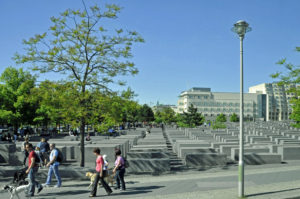
Holocaust Memorial in Berlin, Germany (Photo by Don Knebel)
The Memorial to the Murdered Jews of Europe lies just south of the new American embassy and just east of Ebertstraße, a street once containing a long section of the wall separating East and West Berlin. The 4.7-acre site, within sight of the Brandenburg Gate, previously held the city villa of Joseph Goebbels, one of the architects of Nazi persecution. The memorial itself consists of 2711 rectangular concrete slabs of uniform length and width, with heights ranging from a few inches to more than 15 feet. The slabs, called “stelae,” are positioned on a grid, with their varying heights arranged to create an irregularly undulating appearance that exaggerates the rises and falls of the uneven ground, especially for visitors walking among them. An underground information center contains the names of three million Jewish Holocaust victims.
The memorial was designed by Peter Eisenman, an American architect who won a 1997 design competition after the winner of an earlier competition was rejected by Chancellor Helmut Kohl. Eisenman said his disquieting design suggests what happens when an apparently rational society loses its bearings. As if to prove the point, critics discovered that the German chemical company engaged to coat the stelae against graffiti was associated with the firm that produced cyanide tablets for concentration camp death chambers, temporarily halting construction. The memorial was finally dedicated on May 10, 2005, almost sixty years to the day of the German surrender in World War II.
Since the Memorial’s opening, the stelae have been repeatedly marred with swastikas and other anti-Semitic markings. Unfortunately, “Never Again” far too often seems less a promise than a hope.
Comments are closed.